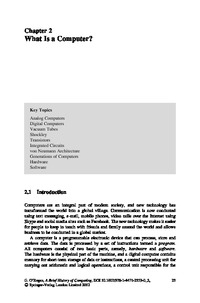What Is a Computer?Zu finden in: A Brief History of Computing, 2012
 |
 |
 Diese Seite wurde seit 13 Jahren inhaltlich nicht mehr aktualisiert.
Unter Umständen ist sie nicht mehr aktuell.
Diese Seite wurde seit 13 Jahren inhaltlich nicht mehr aktualisiert.
Unter Umständen ist sie nicht mehr aktuell.
 Zusammenfassungen
Zusammenfassungen
 Chapter 2 discusses the question as to what a computer is. Early mechanical
calculators are considered, and the discussion then moves on to analog and digital
computers. The evolution of the digital computer from vacuum tube technology to
transistor and integrated circuit technology is considered.
Chapter 2 discusses the question as to what a computer is. Early mechanical
calculators are considered, and the discussion then moves on to analog and digital
computers. The evolution of the digital computer from vacuum tube technology to
transistor and integrated circuit technology is considered. The objective of this chapter was to discuss the nature of a computer, and to briefly
describe the evolution of the computing field from the invention of the slide rule
and mechanical calculators in the seventeenth century to the development of analog
computers and up to the birth of the digital computer.
The objective of this chapter was to discuss the nature of a computer, and to briefly
describe the evolution of the computing field from the invention of the slide rule
and mechanical calculators in the seventeenth century to the development of analog
computers and up to the birth of the digital computer.Acomputer is a programmable electronic device that can process, store and retrieve data. All computers consist of two basic parts, namely, hardware and software. The hardware is the physical part of the machine, and software is a set of instructions that tells the computer what to do.
The early digital computers built in the 1940s and 1950s were large machines consisting of thousands of vacuum tubes. Their computational power was a fraction of that of the personal computers used today.
Transistors began to replace vacuum tubes from the mid-1950s. These are small and use very little power, and so the resulting machines were smaller, faster and more reliable. Integrated circuits were introduced in the 1960s, and over a billion transistors may be placed on an integrated circuit. This allows a massive amount of computational power to be placed on a very small chip.
The development of the microprocessor allowed a single chip to contain all of the components of a computer from the CPU and memory to input and output controls. The microprocessor could fit into the palm of the hand, whereas the early computers filled an entire room.
The fundamental architecture of a computer has remained basically the same since it was proposed by von Neumann and others in the 1940s. It includes a central processing unit which includes the control unit and the arithmetic unit, an input and output unit and memory.
 Dieser Text erwähnt ...
Dieser Text erwähnt ...
 Personen KB IB clear | Gordon Moore | ||||||||||||||||||
 Begriffe KB IB clear |  Computer Computer computer
, computer
,  Hardware Hardware hardware
, hardware
,  Moore's law Moore's law Moore's law
, Moore's law
,  Software Software software software
| ||||||||||||||||||
 Bücher |
| ||||||||||||||||||
 Texte |
|
 Tagcloud
Tagcloud
 Zitationsgraph
Zitationsgraph
 Zitationsgraph (Beta-Test mit vis.js)
Zitationsgraph (Beta-Test mit vis.js)
 Anderswo finden
Anderswo finden
 Volltext dieses Dokuments
Volltext dieses Dokuments
 Anderswo suchen
Anderswo suchen 
 Beat und dieser Text
Beat und dieser Text
Beat hat Dieser Text während seiner Zeit am Institut für Medien und Schule (IMS) ins Biblionetz aufgenommen. Er hat Dieser Text einmalig erfasst und bisher nicht mehr bearbeitet. Beat besitzt kein physisches, aber ein digitales Exemplar. (das er aber aus Urheberrechtsgründen nicht einfach weitergeben darf). Aufgrund der wenigen Einträge im Biblionetz scheint er es nicht wirklich gelesen zu haben. Es gibt bisher auch nur wenige Objekte im Biblionetz, die dieses Werk zitieren.











 , 214 kByte)
, 214 kByte)  Biblionetz-History
Biblionetz-History